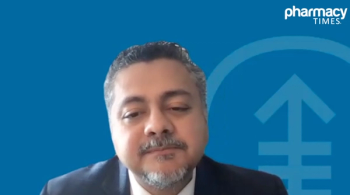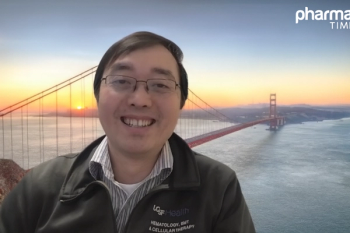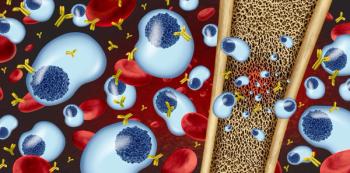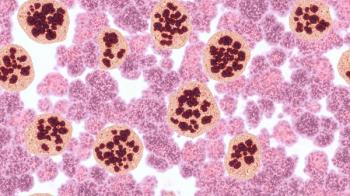
FDA Issues Complete Response Letter for Glofit-GemOx in R/R DLBCL
Key Takeaways
- The FDA's complete response letter cited insufficient evidence from the STARGLO trial for glofitamab's second-line DLBCL indication in the US.
- Glofitamab, a CD20xCD3 bispecific antibody, showed improved overall and progression-free survival in the STARGLO trial compared to R-GemOx.
The CRL states that the STARGLO data do not provide sufficient evidence to support the second-line indication in the US patient population.
The FDA issued a complete response letter (CRL) for the supplemental biologics license application (sBLA) for glofitamab-gxbm (Columvi; Genentech) in combination with gemcitabine (Gemzar; Eli Lilly and Co) and oxaliplatin (GemOx, Eloxatin; Sanofi) for the treatment of patients with relapsed or refractory (R/R) diffuse large B-cell lymphoma (DLBCL) who are not candidates for autologous stem cell transplant. The CRL stated that the data from the phase 3 STARGLO trial (NCT04408638) do not provide sufficient evidence to support the proposed second-line DLBCL indication in the US patient population.1,2
Glofitamab is a CD20xCD3 T-cell–engaging bispecific antibody that is designed to target CD3 on the surface of T cells and CD20 on the surface of B cells. It has 1 region that binds to CD3, a protein on T cells, a type of immune cell, and 2 regions that bind to CD20, a protein on B cells, which can either be healthy or malignant. The dual targeting brings the T cell in close proximity to the B cell and then activates the release of proteins from the T cell that kill cancer cells. The sBLA for glofitamab in combination with GemOx in R/R DLBCL was accepted by the FDA in December 2024.1,2
“While we are disappointed with this outcome, we remain confident in the data supporting the value of [glofitamab] for US patients who have relapsed following initial treatment, and its key role as monotherapy in the third-line setting,” Levi Garraway, MD, PhD, chief medical officer and head of global product development, said in a news release. “We are committed to bringing [glofitamab] to more people living with lymphoma and are actively exploring its potential in additional treatment settings, including as frontline therapy.”1
STARGLO is an open-label, multicenter, randomized phase 3 STARGLO clinical trial which compared the efficacy and safety of glofitamab and GemOx (Glofit-GemOx) with rituximab (Rituxan; Genentech) and GemOx (R-GemOx) in patients with R/R DLBCL who have received at least 2 prior lines of treatment.1-3 According to findings published in Journal of Clinical Oncology, the trial investigators enrolled 274 patients who were randomly assigned to receive either Glofit-GemOx (n = 183) or R-GemOx (n = 91).4
The trial’s primary end point was overall survival (OS), and the secondary end points were progression-free survival (PFS), complete response (CR) rate, objective response rate, and duration of objective response. Additionally, safety, tolerability, and frequency of adverse events (AEs) were assessed.1-4
At 2 years of follow-up (median: 24.7 months), Glofit-GemOx demonstrated superior median OS (not evaluable [NE] vs 13.5 months; HR 0.60 [95% CI: 0.42–0.85]), median PFS (13.8 vs 3.6 months; HR 0.41 [95% CI: 0.29–0.58]), and CR rate (58.5% vs 25.3%) compared with R-GemOx. For patients who were treated with Glofit-GemOx and achieved a CR (n = 107), the median duration of CR was not reached ([95% CI 27.2–NE]; median CR follow-up: 18.2 months [range: 15.2–19.3]). For patients with a CR at the end of treatment (n = 82), the OS and PFS rates at 1 year following the end of treatment were 89.3% and 82.4%, respectively.4
Notably, Glofit-GemOx’s safety profile was consistent with prior research and the known profiles of each individual drug. Cytokine release syndrome (CRS) was the most common AE in patients who received treatment with glofitamab, most of whom experienced grade 1 (32.0%), followed by grade 2 (10.5%) and grade 3 (2.3%). Events that were considered consistent with immune effector cell-associated neurotoxicity syndrome occurred in 4 patients, all of which were concurrent with CRS. These data were presented at the 2025 American Society of Clinical Oncology Annual Meeting.4
DLBCL is an aggressive blood cancer and is the most common form of non-Hodgkin lymphoma in the US. Although many patients are responsive to treatment, most of those who relapse or are refractory to following treatments have poor outcomes, emphasizing a need for treatment options for this population. According to the manufacturers, discussions with the FDA are underway to confirm the phase 3 SKYGLO study investigating glofitamab in combination with polatuzumab vedotin-piiq (Polivy; Genentech), rituximab, cyclophosphamide, doxorubicin, and prednisone for patients with previously untreated large B-cell lymphoma as the new postmarketing requirement.1,2
"For patients with this aggressive form of lymphoma, effective treatment after relapse is paramount. The STARGLO study showed that [Glofit]-GemOx significantly improves OS and could have a positive impact for patients earlier in their treatment journey. This regimen is already approved in over 35 countries, which underscores the urgent need it addresses," STARGLO principal investigator Jeremy Abramson, MD, director of the Jon and Jo Ann Hagler Center for Lymphoma at the Massachusetts General Hospital Cancer Center, said in the news release.1
REFERENCES
1. Businesswire. Genentech Provides Update on Supplemental Biologics License Application for Columvi Combination for People With Relapsed or Refractory Diffuse Large B-cell Lymphoma. News release. July 18, 2025. Accessed July 18, 2025. https://www.businesswire.com/news/home/20250718250985/en/Genentech-Provides-Update-on-Supplemental-Biologics-License-Application-for-Columvi-Combination-for-People-With-Relapsed-or-Refractory-Diffuse-Large-B-cell-Lymphoma
2. Genentech. FDA Accepts Supplemental Biologics License Application for Genentech’s Columvi Combination for People With Relapsed or Refractory Diffuse Large B-Cell Lymphoma. News release. December 4, 2024. Accessed July 18, 2025. https://www.gene.com/media/press-releases/15045/2024-12-04/fda-accepts-supplemental-biologics-licen
3. A Phase III Study Evaluating Glofitamab in Combination With Gemcitabine + Oxaliplatin vs Rituximab in Combination With Gemcitabine + Oxaliplatin in Participants With Relapsed/Refractory Diffuse Large B-Cell Lymphoma. ClinicalTrials.gov identifier: NCT04408638. Updated July 14, 2025. Accessed July 18, 2025. https://clinicaltrials.gov/study/NCT04408638
4. Abramson JS, Ku M, Hertzberg H, et al. Glofitamab plus gemcitabine and oxaliplatin (Glofit-GemOx) in patients (pts) with relapsed/refractory (R/R) diffuse large B-cell lymphoma (DLBCL): 2-year (yr) follow-up of STARGLO. J Clin Oncol. 2025;43(Number 16 suppl). doi:10.1200/JCO.2025.43.16_suppl.7015
Newsletter
Stay informed on drug updates, treatment guidelines, and pharmacy practice trends—subscribe to Pharmacy Times for weekly clinical insights.




















































































































































































































